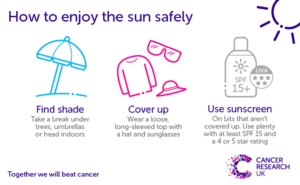In warmer weather be Sun Safe and protect yourself from getting sunburnt.
Skin Cancer (non-melanoma)
Most skin cancers are caused by skin damage from sun exposure over a long period of time, or from a history of getting sunburnt. The older you are, the more likely you are to develop skin cancer. But it can develop in younger people too. The most common sign of melanoma is the appearance of a new mole or a change in an existing mole. Because people are living longer, they are exposed to more sun over their lifetimes. The ultraviolet light in sunlight damages the DNA in the skin cells. Sunburn doesn’t just happen abroad or on summer holidays. Even on cloudy or foggy days you can still get sunburned. Up to 80% of UV rays pass through cloud or mist, so be sure to still find shade, cover up and use sunscreen on the areas you cannot cover.
Sun Safety
- The sun is often strong enough in the UK to damage your skin, even if it’s cold or cloudy.
- People who work outside such as farm workers, gardeners and building site workers are also at an increased risk of non-melanoma skin cancer.
- You can’t tell if you are at risk of burning by the temperature outside. This is because you can’t feel UV rays. The UV index tells us how strong the sun’s UV rays are. If it is 3 or above, you need to protect your skin.
- Use the shadow rule: if it is shorter than your height this means that the sun’s UV rays are strong.
- Cover up with clothing, hats, and UV protection sunglasses.
- Spend time in the shade, especially between 11am and 3pm (in the UK from mid-March to mid-October)
- Use sunscreens of at least SPF 15 and 4 or 5 stars. Reapply regularly, together with shade and clothing too.
- The NHS recommends children under 6 months should be kept out of direct sunlight.
Signs and Symptoms
In most cases, melanomas have an irregular shape and are more than 1 colour. They are usually painless and grow slowly. But sometimes they may grow quickly. They can appear anywhere on your body. The mole may also be larger than normal and can sometimes be itchy or bleed. If you notice anything unusual on your skin, make an appointment to show it to your GP. It might help to take a photograph, so you can check for any changes. Remember there are many other skin conditions that are not cancer, especially in older people. It can be more difficult to notice changes if you have darker skin. This is because symptoms of skin cancer may be less obvious than in people with paler skin. If you notice any changes, such as a sore that does not heal, always see your GP.
- Check for a mole that gradually changes shape, size, or colour, or one that feels itchy or sometimes bleeds.
- A spot that has a raised area of skin, looks pink or red or feels tender to the touch.
- Areas of skin that may be smooth and pearly-white or waxy.
- A firm, red lump or one that may look sunken in the middle (pearly brown or black if you have darker skin)
- A flat, red spot that is scaly and crusty – or a spot that develops a crust or scab.
- A pale non-healing scar, or an area of damaged skin that begins but never completely heals.
No sunscreen, no matter how high the factor, can provide 100% protection. Sunscreen shouldn’t be used to extend your time in the sun, and it doesn’t make tanning safe. If want to tan, then using fake tan is a safer way to do it.UV radiation from sunbeds (tanning beds) can damage the DNA in your skin cells. Like the sun, sunbeds, sunlamps and tanning booths give off ultraviolet (UV) radiation. This radiation can damage the DNA in your skin cells.
Sun Safety for Children
Sun safety is important at all ages. Protect children’s skin using a combination of shade, clothing, and sunscreen. Covering skin with clothing helps to reduce UV rays reaching the skin, perhaps wearing a t-shirt in the paddling pool or a hat when at the park. Remember sunglasses and hats are a great way to protect the eyes and face, too.
Children and teenagers might need a reminder or a helping hand but setting a good example yourself is a great way to help them learn good habits. Another handy tip to help you work out when the sun is strong is the ‘shadow rule’. It’s simple and it works anywhere in the world. It’s also a fun way to talk to children about enjoying the sun safely.
Look at your shadow and if it is shorter than your height this means that the sun’s UV rays are strong. So that’s when you’re more likely to burn and need to take care and protect your skin, especially if you get sunburnt easily.

